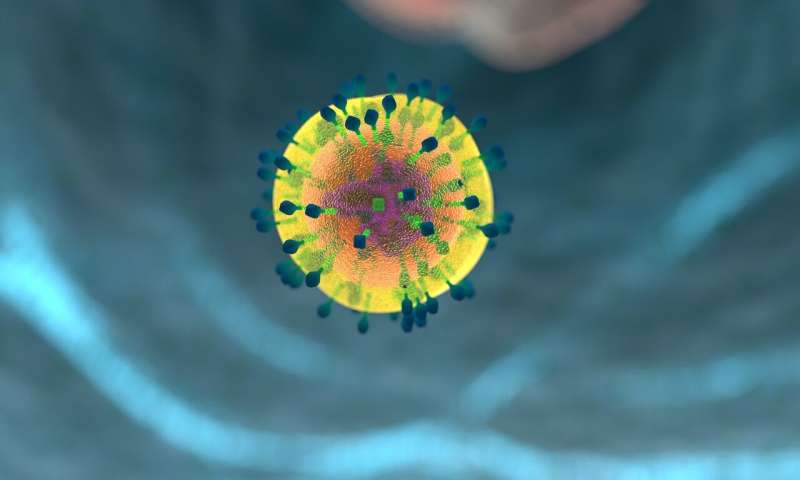This article has been reviewed according to Science X's editorial process and policies. Editors have highlighted the following attributes while ensuring the content's credibility:
fact-checked
peer-reviewed publication
trusted source
proofread
'Double life' of key immune protein reveals new strategies for treating cancer and autoimmune diseases

Insights into the workings of an immune cell surface receptor, called PD-1, reveal how treatments that restrict its action can potentially be strengthened to improve their anticancer effect, a new study shows. The same findings also support experimental treatment strategies for autoimmune diseases, in which the immune system attacks the body, because stimulating the action of PD-1, as opposed to restricting it, can potentially block an overactive immune response.
Led by researchers at NYU Langone Health's Perlmutter Cancer Center and the University of Oxford, the study is published in the journal Science Immunology.
The study results revolve around the body's immune system, which is primed to attack virally infected and cancerous cells while leaving normal cells alone. To spare normal cells from immune attack, the system uses "checkpoints," sensors on the surface of immune cells, including T cells, which turn them off or dampen activation when they receive the right signal. The immune system recognizes tumors as abnormal, but cancer cells can hijack checkpoints to turn off immune responses.
Among the most important checkpoints is a protein called programmed cell death receptor 1 (PD-1), which is shut down by a relatively new drug class called checkpoint inhibitors to make tumors "visible" again to immune attack. Such drugs are at least somewhat effective in a third of patients with a variety of cancers, say the study authors, but the field is urgently seeking ways to improve their performance and scope.
At the same time, PD-1 signaling is slowed in autoimmune diseases like rheumatoid arthritis, lupus, and type 1 diabetes, such that the action of unchecked immune cells creates inflammation that can damage tissues. Agonists, drugs that stimulate PD-1, are now showing promise in clinical trials.
Many immune checkpoints are receptors on the surface of T cells that act to translate docking information from the outside of the cell to the signaling portion of the receptor inside the cell. Connecting the outside-of-the-cell portion of PD-1 with the inside portion is the transmembrane segment. Many immune receptors function in pairs called dimers, but to date, PD-1 has been thought to function alone, not in the dimer form.
Study results showed that PD-1 forms a dimer through interactions of its transmembrane segment. Researchers say this finding is in sharp contrast to other immune receptors, which typically form dimers through the segment of the receptor that is outside the cell.
Further immune cell testing in mice showed that encouraging PD-1 to form dimers, specifically in the transmembrane domain but not in its outer or inner regions, increased its ability to suppress T cell activity, while decreasing transmembrane dimerization lowered PD-1's ability to inhibit immune cell activity.
"Our study reveals that the PD-1 receptor functions optimally as dimers driven by interactions within the transmembrane domain on the surface of T cells, contrary to the dogma that PD-1 is a monomer," said study lead investigator and physician-scientist Elliot Philips, MD, Ph.D., an internal medicine resident at NYU Grossman School of Medicine and Perlmutter Cancer Center. Philips is also an alumnus of the Vilcek Institute of Biomedical Sciences at NYU.
"Our findings offer new insights into the molecular workings of the PD-1 immune cell protein that have proven pivotal to the development of the current generation of anticancer immunotherapies, and which are proving essential in the design and developing of the next generation of immunotherapies for autoimmune diseases," said study co-senior investigator and cancer immunologist Jun Wang, Ph.D. Wang is an assistant professor in the Department of Pathology at NYU Grossman and Perlmutter.
"Our goal is to use our new knowledge of the functioning of PD-1 to determine if weakening its dimerization, or pairing, helps make anticancer immunotherapies more effective, and just as importantly, to see if strengthening its dimerization helps in the design of agonist drugs that quiet overactive T cells, tamping down the inflammation seen in autoimmune diseases," said study co-senior investigator and structural biologist Xiang-Peng Kong, Ph.D.
"Presently, research efforts have focused on strengthening PD-1 interactions with its ligands, or signaling molecules, involved with inhibiting T cell action."
"Our new study suggests that efforts to design better drugs should focus on increasing or decreasing PD-1's dimerization to manipulate T cell function," said Kong, a professor in the Department of Biochemistry and Molecular Pharmacology at NYU Grossman and Perlmutter.
Among the study's other findings was that a single change in the amino acid structure of the transmembrane segment can act to either enhance or diminish the inhibitory function of PD-1 in immune responses. The team plans further investigations of PD-1 inhibitors and agonists to see if they can tailor what they say are more effective, "rationally designed" therapies for both cancer and autoimmune disorders.
More information: Elliot Philips et al, Transmembrane Domain Driven PD-1 Dimers Mediate T Cell Inhibition, Science Immunology (2024). DOI: 10.1126/sciimmunol.ade6256. www.science.org/doi/10.1126/sciimmunol.ade6256



















